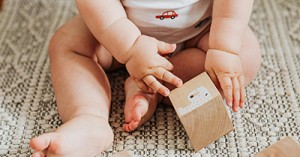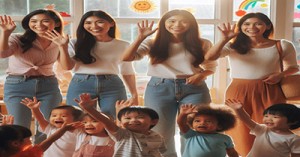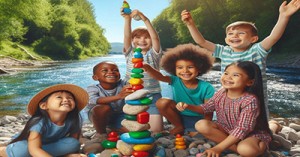Transitions are among the most significant factors that determine the well-being of young children. Their sense of ease, ability to learn and the nature of attachments are vastly impacted by how they experience transitions in the ECEC setting. The following article provides information on Theories and Transitions, Different Types Of Transitions, Benefits Of Planning Transitions With Families and Children and more.
Theories and Transitions
As young children grow, it is inevitable that they encounter changes – in settings, carers, activities and events. Though children widely vary in their ability to cope, to some extent all children need to be supported through bewildering changes with what is known as transition practices. Here is a bit more on the theoretical underpinnings of transition, especially with reference to Attachment theory, Social and Emotional Developmental as well as Well Being.
Attachment Theory
Developed by John Bowlby in 1979, Attachment theory posits that the kind of attachment relationship developed between a caregiver and child not only impacts the child’s experience of their surroundings but determines the quality of their adult relationships as well. And the best life outcomes are provided if the individual is able to develop a secure attachment with caregivers during infancy. Such secure attachments are particularly important during periods of stress and change. With this in mind, it becomes easier for educators to see why forming a strong attachment/bond with children in their care is fundamental to facilitating any transition for them.
Social and Emotional Development
It is also useful for educators to be cued about childhood developmental theories, particularly related to emotional and social growth, so that they know what to expect at different ages and stages in their learners’ lives. One of the most relevant of these is the notion of developmental milestones according to which children between one and two years tend to show anxiety when separating from significant people in their lives1. When upset or afraid due to unanticipated changes, children may further seek comfort and reassurance.
Awareness of such developmental theories, coupled with knowledge of children in their care, will help educators to better plan for successful transitions. For example, the next time, a toddler cries when separating from their parent in the morning, the educator will not only know that the behaviour is typical for many children in this age group but will feel more confident in preparing transition practices to support that particular child. At the same time though, educators need to bear in mind that all children will develop at different rates and so the most effective transition strategies can only be those that are directed to the child’s unique physical, cognitive, emotional, linguistic strengths and abilities rather than a one-size-fits-all approach based solely on developmental domains.
Well Being
Yet another aspect of children’s inner lives that necessitate careful attention to transition practices is that of their well-being. Children’s well-being can be understood as feeling at ease, being spontaneous and free of emotional tensions. Their sense of well-being is not only crucial to secure ‘mental health in children but their ability to learn as well. For all these reasons, educators need to consider how transition practices might impact the children’s sense of well-being and thereby plan ways to support them with strategies like developing close, interpersonal bonds and offering calming, predictable routines, among others.
Different Types of Transitions
As children grow and develop, they inevitably experience a number of changes – from one space, set of people or activity to another. Again there may be significant events in a child’s which may impact them in ways that don’t apply to other children. In all instances though, young children will need varying degrees of help to cope with some common changes in their lives. In early childhood settings, transitions are times when children move between and adapt to different spaces or places and with different people, experiences, expectations and routines. Here is a bit more on the different types of transitions in the ECEC context.
Going From Home and Community Into An ECEC Service
This is the first major transition common to all children when they leave the folds of their immediate family and join a daycare or some type of early childhood service. This is probably the first time that a baby or toddler finds themselves away from parents for a longer part of the day and thus the transition needs to be strongly supported for both children and parents.
Moving From One Age Grouping Or Room To Another
Children who start in daycare may experience transitions as they move from one section to another - for example, from the baby room to the toddler room. Though within the same service, such transitions can upset a young child who had perhaps started bonding with a particular carer. Such room-to-room transitions can be supported by getting children used to new staff and planning for settling-in sessions.
Such transitions usually happen when children change settings as they move from one age group to another – like the infant room to the toddler room. Sound out families and older children about proposed room changes and where possible, incorporate their inputs and requests. Check transition practices in your service to ensure that children are gradually introduced to their new environment and educators. Also, find out how important information about the child is handed over to the child’s new educators. Consider whether it is possible for an educator to move with a child or group of children to the next room so as to maintain some consistency in relationships. Let the child drop by the new room so as to make the acquaintance of its inhabitants, equipment and layout before they actually make the move. It is equally important for educators in the new room to invest time and effort in nurturing caring relationships with a new child and their families.
Starting At A New ECEC Service
Sometimes work requirements of parents or a family relocation may end up children moving to a new ECEC service. Such transitions can also be difficult as the child may have gotten used to carers in the previous service. Both the child and families will need additional support in making this type of transition.
Yet another type of transition may involve a child moving between different care settings within the span of the same day; thus a child may attend a nursery/pre-school in the morning, and then a child-minder in the afternoon or move from a universal service such as long day care to an early intervention service later in the day.
This includes children and families who are joining your service for the first time or moving from an ECEC setting to yours. Consider how your service prepares both educators as well as children and their parents for the impending transition. Children might be given photos that depict groups of children, the staff and different aspects of life at the service while enrolment meetings, newsletters and fliers may be used to share with families, information about the service, staff and practices. Likewise, meetings and forms can also be used by the service to find out from families more about the child’s home routine, cultural traditions/values, and likes/dislikes.
Orientation visits can be planned to gradually help children and parents move through the transition event. During this time, a new child might be allowed to with a sibling, a child they know in another group or an educator they know from before. A primary carer system is another good transition practice whereby each child is allocated to a particular educator who is the key person to support the child and family, especially during the orientation period.
Leaving an ECEC service and starting full-time school
This again is a common transition that all children experience as they grow up and get ready for primary school. Even when at full-time school, a child may still participate in before and after school programs and thus may need support with intra-day transitions.
Transitions may not just be across different spaces but can involve moving from one schedule to another as well. These types of transitions can be the result of planned routines or curricula schedules at a service like going from inside to outside time, from free play to a teacher-led, structured activity or from a solitary activity to group time.
The time when children move from service to a full-fledged school is another turning point in their lives. For this major transition, it is important to build partnerships with a local school so that children can familiarise themselves with the new environment, including school teachers, grounds, libraries, music room and so on. Helping children learn about road and bike safety, adding school uniforms and stationery to the home corner and even roping in local businesses to congratulate new joiners can all build positive interest and pleasant associations around this significant time of change.
Transitions Between Activities
Such transitions include moving between outdoor and indoor activities, high and low energy activities, solitary and group activities or across functions like between learning and snacking or play and bathroom time. It is important to establish routines and rituals to let children prepare for the impending change or to give them enough time to wrap up a favourite activity. Such transitions also necessitate reflection on which children need more prep time than others or different types of transition cues. For example, children on the autism spectrum or linguistically diverse children may find it easier to go through transitions when supported by visual routines. Above all, transitions at your service need to be subject to continuous reflection by educators to see how children are coping and if they need to be updated through policy review.
Benefits Of Planning Transitions With Children And Families
The Early Years Learning Framework lists continuity of learning and transitions among the eight pedagogical practices that promote children’s learning. Transitions, including from home to early childhood settings, between settings, and from early childhood settings to school, offer both opportunities and challenges. Different places and spaces have their own purposes, expectations and ways of doing things. It is imperative that children’s prior and current experiences are built upon when planning transitions so that they continue to feel secure and connected to familiar people, places and understandings. But such meaningful transitions can happen only when children, families and early childhood educators all contribute to planning them together.
Children Feel Secure
The biggest benefit to planning transitions together is that children get to anticipate change. When children know what to expect they are better prepared for what is in store, leading to lower levels of stress around the transition. And since children feel reassured and secure, they are more likely to make the best of their learning activities and experiences. Anxiety is counterintuitive to learning – no matter how enriching a learning environment or carefully planned the learning interventions are, if the child is stressed and miserable, it is unlikely that any meaningful learning can happen. Transitions thus, when planned according to the child’s needs and interests, pave the way for successful development in all areas.
Parents Feel Empowered
Transitions can be as stressful for parents as for children – especially when the child is being separated from the family for the first time to join daycare. The experience of a child crying, clinging on to the parent and refusing to let go can indeed be emotionally wrenching for both parties. At such times, working with families to plan transition rituals and routines can be a great way to support them through changes. Furthermore, parents know their child best which is why for any transition practice to be really effective, educators need to rope in families so that they are designed in keeping with the child’s needs and interests. Equally importantly, being consulted about their children’s routines will go a long way in making families feel valued which is a great place to begin for any service-family collaboration.
Service Feels Confident
Planning transitions with children reduces the chances of disruptive or stressed behaviour in children which in turn means a smoother day for educators. More importantly, when they are freed of behaviour guidance or settling down duties, educators can focus more on planning and delivering innovative, engaging learning experiences. Also as they collaborate with services, families gain first-hand insight into the service philosophy, practices and the role of the educators which helps them and the larger community understand the service better. Finally working in partnership with families to ensure smooth transitions for children means your service is working toward NQS QA 6.
Further Reading
Guide To Transitions Between Activities In Early Childhood Services - The following article provides information on Supporting Transitions, Transitions, Transition Songs and Chants and more.
Supportive Transition Practices For Preschoolers Going To Primary School - The following article provides Educators with a guide on planning supportive transition practices for preschoolers going to primary school the following year including practical ideas to involve children, partnering with families, collaborating with other professionals, planning transition programs and more.
Transition Songs for Children - The following provides a list of transition songs that help move children from one experience to another. For example: from free play to clean-up time or from group time to lunchtime. Transitions can be chants, songs or short stories. You can use transitions to introduce the children to music, rhythm and rhyming.
References:
Plan Effective Transitions For Children
Belonging, Being & Becoming
Transitions: Moving in, moving up and moving on







 As an Educator in Australia, your pay rate falls under the Children’s Services Award 2010. This award states the minimum amount that an employer can
As an Educator in Australia, your pay rate falls under the Children’s Services Award 2010. This award states the minimum amount that an employer can When working as a qualified Early Childhood Teacher (with a university degree) within a service, your rate of pay will come from the Educational Services
When working as a qualified Early Childhood Teacher (with a university degree) within a service, your rate of pay will come from the Educational Services When working as a Diploma Qualified Educator your pay rate is from the Children's Services Award 2010. This Award states your minimum rate of pay
When working as a Diploma Qualified Educator your pay rate is from the Children's Services Award 2010. This Award states your minimum rate of pay When working as a Cert 3 Qualified Educator, your pay rate is from the Children's Services Award 2010. This Award states your minimum rate of
When working as a Cert 3 Qualified Educator, your pay rate is from the Children's Services Award 2010. This Award states your minimum rate of Educational Leaders play a crucial role in their early childhood service by ensuring that the educational program aligns with best practices and supports the holistic
Educational Leaders play a crucial role in their early childhood service by ensuring that the educational program aligns with best practices and supports the holistic In early childhood education and care, ratios are more than a technicality—they are a frontline safeguard. Every child deserves responsive supervision, emotional connection, and developmental
In early childhood education and care, ratios are more than a technicality—they are a frontline safeguard. Every child deserves responsive supervision, emotional connection, and developmental Here’s a comprehensive Mobile Phone and Smart Watch Policy tailored for early childhood education and care (ECEC) services in Australia, aligned with the latest 2025
Here’s a comprehensive Mobile Phone and Smart Watch Policy tailored for early childhood education and care (ECEC) services in Australia, aligned with the latest 2025 With the new national child safety reforms kicking in on 1 September 2025, early childhood services like yours have a real opportunity to lead the
With the new national child safety reforms kicking in on 1 September 2025, early childhood services like yours have a real opportunity to lead the The Sea of Fish Challenge is a national initiative that invites children, educators, families, and communities to create and display fish artworks as a symbol
The Sea of Fish Challenge is a national initiative that invites children, educators, families, and communities to create and display fish artworks as a symbol Across the early childhood education and care sector, educators are sounding the alarm: current staffing ratios are insufficient to deliver safe, meaningful, and developmentally appropriate
Across the early childhood education and care sector, educators are sounding the alarm: current staffing ratios are insufficient to deliver safe, meaningful, and developmentally appropriate


